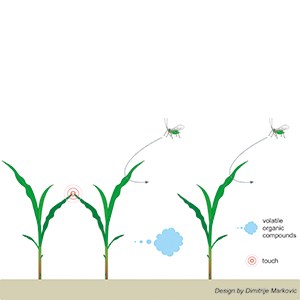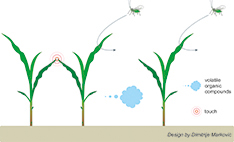Crowded maize plants activate their defence, and emit odours that make plants further away do the same

The volatile emissions of a plant change in response to physical contacts with neighbouring plants, and these volatiles can then be perceived by plants further away. Now, researchers at the Swedish University of Agricultural Sciences have shown that untouched maize plants respond in the same way as neighbouring maize that have been touched. The induced changes in volatile-exposed plants make them less attractive to aphids. In the future, this discovery could be used to trigger the defence of all plants in a greenhouse by treating only a few of them.
Plants cannot move from the site where they grow, but they can reposition or restructure themselves in response to their environment. For instance, leaves can be moved in order to better catch the light. As a result, neighbouring plants can come in contact with one another and this can serve as an early signal of the presence of potential competitors for available resources such as nutrients, light and water.
The researchers at SLU have previously demonstrated that touching aboveground parts of a maize plant can affect underground plant communication, inducing changes in the growth strategies of neighbouring untouched plants.
“In this study we wanted to see how untouched maize plants respond to airborne chemical signals released from touched plants, says Dimitrije Markovic, postdoctoral researcher at SLU.
He conducted the study together with Velemir Ninkovic and researchers from Florence University, Italy, and Penn State University, USA. They tested the communication between plants by exposing one individual to the volatiles of a neighbour which had been gently touched with a soft makeup brush for one minute per day to mimic the light touch of nearby plants.
They found that untouched plants that had been exposed to volatiles from touched plants activated the same defence related genes as the touched ones. Interestingly, both the touched plants and the volatile-exposed untouched neighbour plants were less attractive to aphids. That was an unexpected discovery and the researchers call the phenomena the ‘mirroring effect’.
“Our study shows that touching induced volatiles are directly involved in plant-plant communication as an effective trigger for rapid defence synchronization among nearby plants, says Velemir Ninkovic, researcher at SLU.
Velemir Ninkovic's research group has been studying communication between plants for several years and is interested in how this mechanism can be used in plant protection. There are many studies on how damaged plants can influence the plants around. For example, a plant emits different volatile chemicals when it is attacked by an insect and this can cause nearby plants to activate their chemical defence. The research at SLU has largely focused on the communication between undamaged plants, a relatively new field of research.
The newly discovered mirroring effect can be useful in plant protection. It means that each single plants does not need to be touched at the plant community level due to volatile interaction between plants which trigger induced resistance. This information could be used as a protection method for pest management in greenhouses. However, more research is needed for the application of the observed phenomenon in the future plant protection.
The scientific article
Dimitrije Markovic, Ilaria Colzi, Cosimo Taiti, Swayamjit Ray, Romain Scalone, Jared Gregory Ali, Stefano Mancuso, Velemir Ninkovic. 2018. Airborne signals synchronize the defenses of neighboring plants in response to touch. Journal of Experimental Botany. https://doi.org/10.1093/jxb/ery375

Please click here if you want to see a larger picture
Contact
Velemir Ninkovic, reseacher
Department of Ecology
The Swedish University if Agricultural Sciences
velemir.ninkovic@slu.se, 018-67 25 41